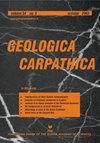伊朗扎格罗斯褶皱冲断带中部地震活动性参数变化及其与构造特征的联系
IF 1.5
4区 地球科学
Q4 GEOSCIENCES, MULTIDISCIPLINARY
引用次数: 0
摘要
本文章由计算机程序翻译,如有差异,请以英文原文为准。
Variation of seismicity parameters and its link to tectonic features of the central portion of the Zagros Fold-Thrust Belt, Iran
: The Zagros Fold-Thrust Belt is one of the most tectonically active regions in the world. The seismicity of this belt is affected by various factors and has certain complexities. This paper provides the results of assessment of temporal and spatial seismicity variations of the central portion of the belt in Fars and Bushehr provinces and their link to regional tectonic properties. Relatively, everywhere in the belt, the geometry of the folds has been mainly affected by thrusts and basement faults. There is a meaningful link between seismic activity and folding in the belt. The most abundant types of folds are detachment folds, fault bend and fault propagation folds. They play an important role in the spatial seismicity of the area. The maximum number of seismic events have medium magnitude which ranges between 2.5 and 3. There is a decreasing trend of a and b parameters from south-west to north and north-east where the occurrence of higher magnitudeearthquakesisexpected.Temporalanalysisofseismicityshowsthatearthquakeswithmagnitude≥ 6.5have a ten-year return period in the region. The occurrence of several earthquake groups in the belt was in the form of swarms showing point or linear spatial distribution. Some of these possible swarms are around transverse faults, salt domes and some are related to blind faults, which indicate the complexity of the seismicity in this belt. Spatial distribution of low magnitude seismic clusters is also influenced by two other factors (1) existence of frequent salt domes many of which might be active and their spatial links to major faults and (2) human-related
求助全文
通过发布文献求助,成功后即可免费获取论文全文。
去求助
来源期刊

Geologica Carpathica
地学-地球科学综合
CiteScore
2.40
自引率
23.10%
发文量
26
审稿时长
>12 weeks
期刊介绍:
GEOLOGICA CARPATHICA covers a wide spectrum of geological disciplines including geodynamics, tectonics and structural geology, volcanology, stratigraphy, geochronology and isotopic geology, karstology, geochemistry, mineralogy, petrology, lithology and sedimentology, paleogeography, paleoecology, paleobiology and paleontology, paleomagnetism, magnetostratigraphy and other branches of applied geophysics, economic and environmental geology, experimental and theoretical geoscientific studies. Geologica Carpathica , with its 60 year old tradition, presents high-quality research papers devoted to all aspects not only of the Alpine-Carpathian-Balkanian geoscience but also with adjacent regions originated from the Mediterranean Tethys and its continental foreland. Geologica Carpathica is an Official Journal of the Carpathian-Balkan Geological Association.
 求助内容:
求助内容: 应助结果提醒方式:
应助结果提醒方式:


